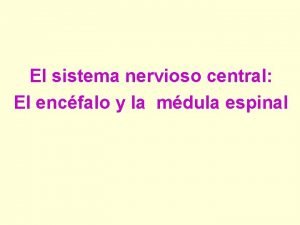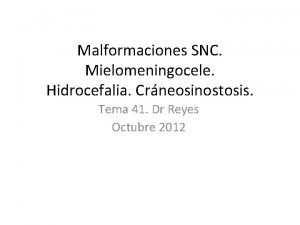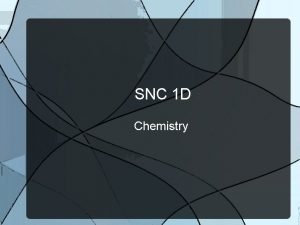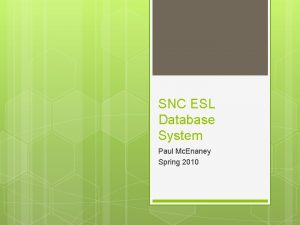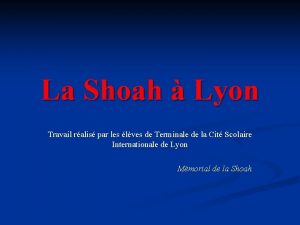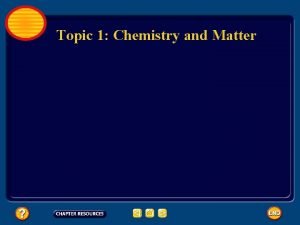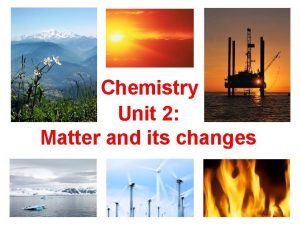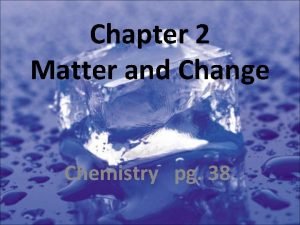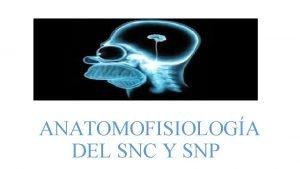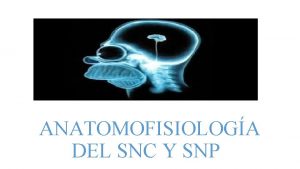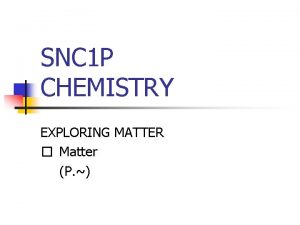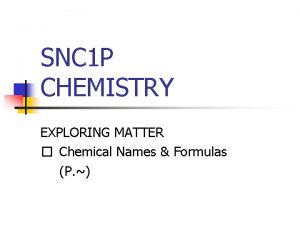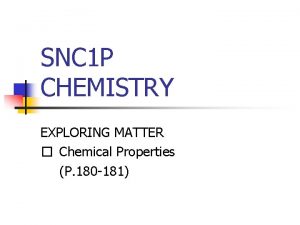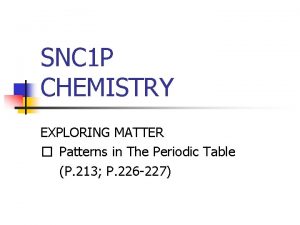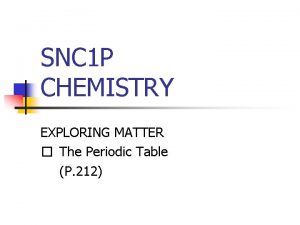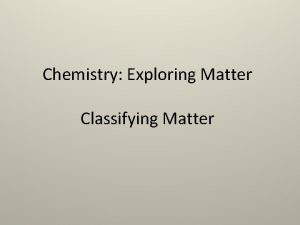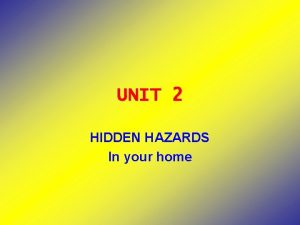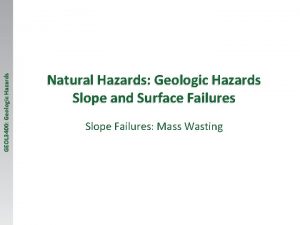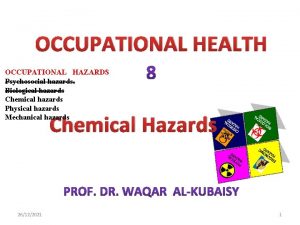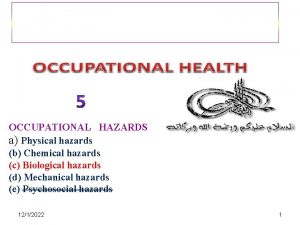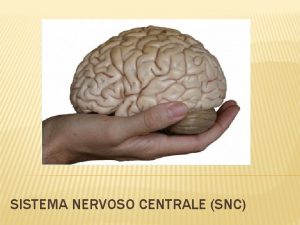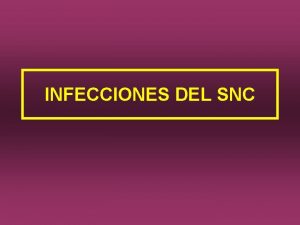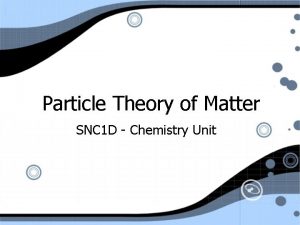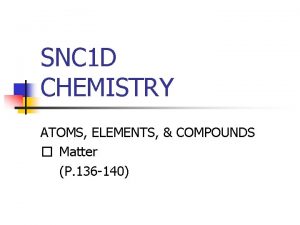SNC 1 P CHEMISTRY EXPLORING MATTER Hidden Hazards






















- Slides: 22

SNC 1 P CHEMISTRY EXPLORING MATTER � Hidden Hazards (P. ~)

Toxic Chemicals, Useful Chemicals All substances, natural and manufactured, are chemicals. Water, gases in the air, the components of our bodies – all are made of elements and compounds and mixtures of them. Our society relies heavily on manufactured chemicals such as paints, plastics, fertilizers, and pesticides. December 15, 2021 1 PCHEM - Hidden Hazards 1

Toxic Chemicals, Useful Chemicals NOTE! While many of these chemicals are potentially hazardous, we continue to produce and use them because they have many benefits and because we have found ways to use them safely and responsibly. December 15, 2021 1 PCHEM - Hidden Hazards 2

From Manufacturing to Recycling For example, the chemicals in a battery are not a problem as long as the battery remains sealed. But if it is thrown in the garbage it may spend a decade in a ditch slowly leaching toxins into the ground water. Proper disposal is essential to protect people and the environment from hazardous chemicals. December 15, 2021 1 PCHEM - Hidden Hazards 3

From Manufacturing to Recycling PRACTICE 1. What do many communities do to prevent hazardous wastes like these from entering landfills? hazardous waste collection days December 15, 2021 1 PCHEM - Hidden Hazards 4

The Hazards of Elements & Compounds Metals are very useful, but some can also cause problems. For example, nickel (Ni) is often used in jewellery but some people are allergic to it and may experience a painful rash that can lead to infection. December 15, 2021 1 PCHEM - Hidden Hazards 5

The Hazards of Elements & Compounds Some metals, such as mercury (Hg) and lead (Pb) are very dense, or “heavy” and remain in the environment for a long time. Mercury, once widely used in mining and industrial processes, frequently found its way into the environment. When foods containing mercury or lead are eaten, internal organs, including the brain, can be damaged. The “Mad Hatter” from Lewis Carroll’s classic fantasy books about Alice in Wonderland was a cartoon version of a hatter affected by mercury poisoning (in the 18 th and 19 th century the heavy metal mercury was used in felt hat making). December 15, 2021 1 PCHEM - Hidden Hazards 6

The Hazards of Elements & Compounds Mercury is an element that is present in the environment naturally, but in very low levels. However, no level of mercury is safe for humans. Mercury poisoning can impair vision, speech, hearing, or balance as well as cause mood swings and memory loss. Some studies have suggested that not only can mercury can lead to birth defects but it may also be the cause of autism in children. December 15, 2021 1 PCHEM - Hidden Hazards 7

The Hazards of Elements & Compounds The plumbing in many older buildings is made of copper pipes held together with solder that contains lead. Both copper and lead are toxic, and both dissolve more readily in hot water than in cold water. That is why hot water from the faucet should never be used to cook food or to make a hot drink. December 15, 2021 1 PCHEM - Hidden Hazards 8

The Hazards of Elements & Compounds In addition, lead was once used in paints to make a pure-white base that does not dull the colours of other paints. The famous Dutch painter Vincent van Gogh may have suffered from lead poisoning. Lead poisoning can cause the retinas of the eyes to swell, making light appear in rings around objects, the way it does in van Gogh’s painting, “The Starry Night. ” December 15, 2021 1 PCHEM - Hidden Hazards 9

The Hazards of Elements & Compounds Arsenic, like many of its neighbours in the periodic table, is toxic and has often been used as a poison. While poisoning people with arsenic may be the stuff of old detective novels, this element still has harmful effects today. Arsenic was used in industrial processes. It was used as a wood preservative for outdoor building materials and as an insecticide on fruit trees. As a result, it has escaped into the environment and contaminated soil, water, air, and food. Although it is no longer used as a wood preservative, many older outdoor structures, such as decks, picnic tables, and playground equipment may still be hazardous. December 15, 2021 1 PCHEM - Hidden Hazards 10

The Hazards of Elements & Compounds Chlorofluorocarbons (CFCs) are another example of why it is important to monitor how chemicals are used. Eighty years ago most homes kept stored food cool in a container with a large block of ice. However, the “icebox” was inconvenient because it needed a constant supply of new ice. The introduction of CFCs changed all that. CFCs are non-toxic and non-flammable gases that can be used in refrigerator units to keep them cool. They were thought to be safe. December 15, 2021 1 PCHEM - Hidden Hazards 11

The Hazards of Elements & Compounds However, in the 1970 s, monitoring showed that the ozone layer, which blocks harmful UV rays from the Sun, was being destroyed by CFCs. The CFCs were not only leaking from old refrigerators but they were being released into the atmosphere from aerosol spray cans and even asthma medications. In response, many countries including Canada met in 1987 and banned their use. By 1997, the ozone layer was starting to get thicker but it could be 2050 before the hole in the ozone layer closes completely. December 15, 2021 1 PCHEM - Hidden Hazards 12

The Hazards of Elements & Compounds Lastly, dichloro-diphenyl-trichloroethane (DDT) is an effective pesticide that kills insects. Although it has not been used in Canada since the 1980 s, it is still used in some countries to kill mosquitoes that transmit malaria. DDT belongs to a group of compounds known as persistent organic pollutants (POPs). A persistent organic pollutant is a chemical that will not break down in the environment. POPs are of special concern because they can build up in the body tissues of prey which are then eaten by predators (recall bioaccumulation and bioamplification). December 15, 2021 1 PCHEM - Hidden Hazards 13

The Hazards of Elements & Compounds As such, issues involving the use of chemicals go beyond whether the product we end up with is safe. For example, it includes concerns about the health of workers exposed to toxic substances during manufacture. It also means preventing toxic substances from escaping into the environment. December 15, 2021 1 PCHEM - Hidden Hazards 14

The Hazards of Elements & Compounds HIDDEN HAZARDS v some chemicals, while useful, are also hazardous: • nickel can cause a painful rash • mercury, lead, DDT, … can lead to bioaccumulation & bioamplification • arsenic is toxic • CFCs almost destroyed the ozone layer • . . . December 15, 2021 1 PCHEM - Hidden Hazards 15

�Check Your Learning 1. Why do people in older homes often let their tap water run for a few minutes before filling their drinking glass? to clear the water of dissolved lead and copper December 15, 2021 1 PCHEM - Hidden Hazards 16

�Check Your Learning 2. Why are some people sensitive to certain types of jewellery? they are allergic to the nickel in the jewellery December 15, 2021 1 PCHEM - Hidden Hazards 17

�Check Your Learning 3. Suppose you go fishing at a pond contaminated with mercury and catch a minnow (a fish at the bottom of the food chain) and a large trout (a fish at the top of the food chain, which eats other fish). Which fish would have a higher concentration of mercury in its body? Explain. the trout because of bioamplification December 15, 2021 1 PCHEM - Hidden Hazards 18

�Check Your Learning 4. Why might aboriginal peoples and people in remote communities feel the effects of heavy metal contamination of fish more than most groups in Canada? they eat more fish (from lakes that have been contaminated with heavy metals) December 15, 2021 1 PCHEM - Hidden Hazards 19

�Check Your Learning 5. Why might it be a good idea for a community to have picnic tables in their parks tested for arsenic? What other items might the community also want to have tested? - the tables might be made of wood that was treated with arsenic - decks, playground equipment, . . . December 15, 2021 1 PCHEM - Hidden Hazards 20

�Check Your Learning WIKI (CHEMISTRY) �. . 1 PCHEM - QUIZ 3 (Atomic Structure) REMEMBER! Be sure to check, correct, and total your quiz before handing it in. December 15, 2021 1 PCHEM - Hidden Hazards 21
 Snc set symbol
Snc set symbol Società in nome collettivo
Società in nome collettivo Snc y snp diferencias
Snc y snp diferencias Snc
Snc Water density
Water density Snc database
Snc database Snc lajaa venissieux
Snc lajaa venissieux Primary taste cortex
Primary taste cortex Whats gray matter
Whats gray matter Section 1 composition of matter chapter 15 answer key
Section 1 composition of matter chapter 15 answer key Section 1 composition of matter
Section 1 composition of matter Gray matter and white matter
Gray matter and white matter Chapter 2 matter section 1 classifying matter answer key
Chapter 2 matter section 1 classifying matter answer key Ecological succession
Ecological succession Rhinencephalon
Rhinencephalon Section 1 composition of matter
Section 1 composition of matter Examples of matter in chemistry
Examples of matter in chemistry Chemistry matter and change chapter 10
Chemistry matter and change chapter 10 Chemistry matter and its changes
Chemistry matter and its changes Non examples of homogeneous mixture
Non examples of homogeneous mixture Flow chart for classifying matter
Flow chart for classifying matter Chemistry matter and change answer key chapter 2
Chemistry matter and change answer key chapter 2 Chemistry matter and change chapter 7
Chemistry matter and change chapter 7


